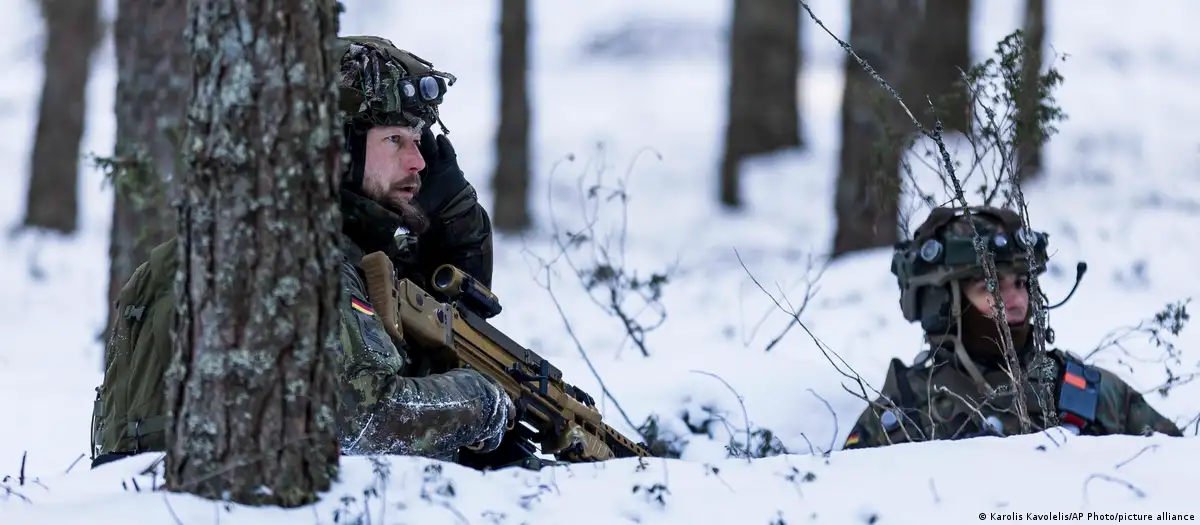According to experts, a stalemate in the war in Ukraine could enable Moscow to recover its military strength to the point where Russia would be able to overcome the military alliance on the battlefield.
(DW) The North Atlantic Treaty Organization (NATO) countries in Europe only have between “five and nine years” to “prepare” in defensive terms to respond to a possible Russian attack on the territory of the military alliance, according to an analysis by the renowned Berlin think tank German Society for International Politics (DGAP).
The authors of the study, Christian Mölling and Torben Schütz, are convinced that “the next war in Europe can only be effectively avoided within a limited period of time”.
They point out that Russia has already converted its arms production into a war economy in the wake of the war against Ukraine. “Even after almost two years of conflict, Russia’s military capacity is greater than it currently appears. The greatest losses in personnel and material have been suffered by the ground forces,” says the analysis, entitled Preventing the Next War.
The text stresses that Germany and NATO are “in a race against time” to increase the war capability of the conventional armed forces to such an extent that their deterrence potential exceeds the Russian calculation for a successful attack, for example, against NATO members Lithuania, Latvia and Estonia.
DGAP security expert Christian Mölling based his conclusions on information from the German secret service and military circles. The analysis is also in line with Germany’s new defense policy guidelines, presented at the beginning of November by German Defense Minister Boris Pistorius. In them, Pistorius for the first time publicly used the expression kriegstüchtig (“skilled for war”) as a goal to be followed in the renewal of the Bundeswehr (German Armed Forces).
“With Putin’s brutal attack on Ukraine, war has returned to Europe,” said Pistorius. “With that, the threat situation has changed. Germany, as the most populous and economically strong country in the center of Europe, must be the backbone of deterrence and collective defense in Europe,” said the minister when presenting the new guidelines for the country’s armed forces.
The basis for calculating possible windows of time for NATO to avoid war through greater potential for intimidation is based on the assumption that Russia would manage to freeze the war in Ukraine. This would give the Kremlin time to recompose its ground forces.
However, hardly anyone in Berlin’s political circles believes that Russia’s war of aggression will quickly reach such a standstill. “Both sides have military plans to continue,” said Nico Lange, an expert on Ukraine and Russia at the Munich Security Conference, in an interview with DW. “I think we have to assume that this will continue for a while.”

Trench warfare
Ukrainian commander Valeriy Saluschnyj warned recently, however, that military aid from the 50 nations supporting his country, led by the US, has only led to a “stalemate”. The front line in eastern and southern Ukraine has hardly changed during the Ukrainian counter-offensive since June.
“In trench warfare, however, Russia would have the upper hand, because its arms industry has increased productivity and it has almost unlimited artillery weapons at its disposal,” warns Austrian military analyst Markus Reisner. He believes that Ukraine can only succeed in a war of movement. To make this possible again next spring, Ukraine needs more modern weapons from the West.
Many analysts believe that the front in Ukraine is turning into an increasingly electronic battlefield. There is increasing talk of the use of artificial intelligence in warfare. “It’s about controlling the electromagnetic field of radio transmission signals and drone controls,” explains Reisner. Lange also confirms that Russia is now able to interfere very successfully with Ukrainian satellite-guided weapons.
This even applies to the US-supplied Himars rocket launchers, with which Ukraine managed to disrupt the Russian supply line by recapturing territory a year ago. “Russia is very successful at jamming,” says Lange.
The term jamming refers to the intentional interference with enemy satellite, radar and radio signals. This is particularly significant as the conflict in Ukraine has increasingly turned into a drone war. These not only attack with weapons, but also provide images and, together with satellite reconnaissance, ensure a transparent front. “Russia has also armed itself in this respect,” points out Lange.
Apparently, the economic sanctions of the European Union and the United States have not prevented Russia from continuing to have access to microchips and other high-tech products. “Russia also has its own satellite navigation system to guide missiles,” says Lange.
Strengthening NATO
According to the study, the assessment is gaining strength in Berlin that Russia can rapidly renew its ground forces with the continuous production of weapons. And in such a way that its combat power will exceed NATO’s current potential for intimidating a conventional war in Europe.
“Experts and intelligence services estimate that Russia will need six to ten years to rebuild its army to the point where it can dare to attack NATO,” Mölling points out. As a result, NATO only has five to nine years to arm itself so that an attack from Russia can be repelled.
“An attack by Russia on NATO territory is something that can no longer be ruled out,” said Mölling. “The question is no longer whether Germany and NATO need to be prepared for a war, but when.”
*** Translated by DEFCONPress FYI Team ***
